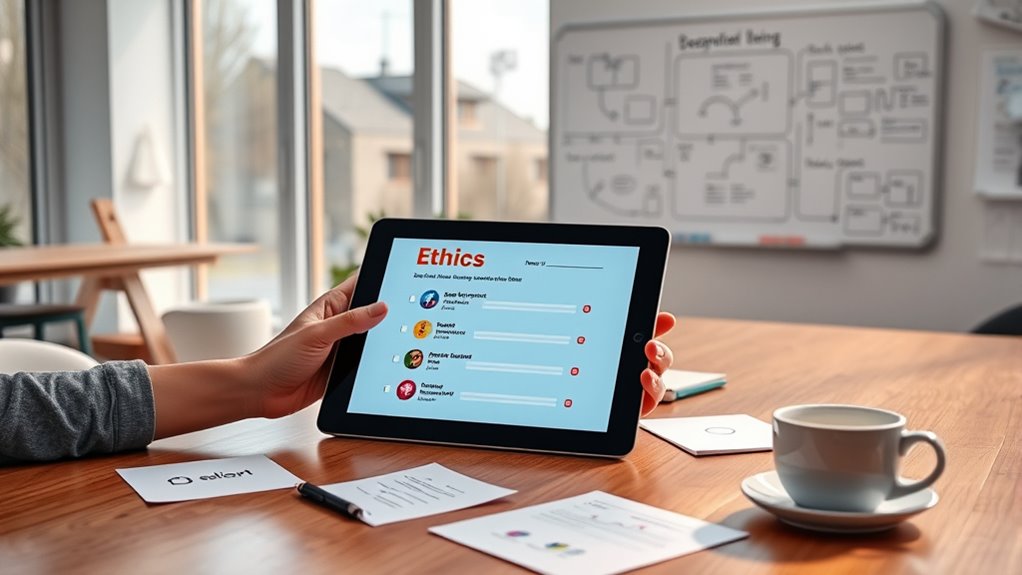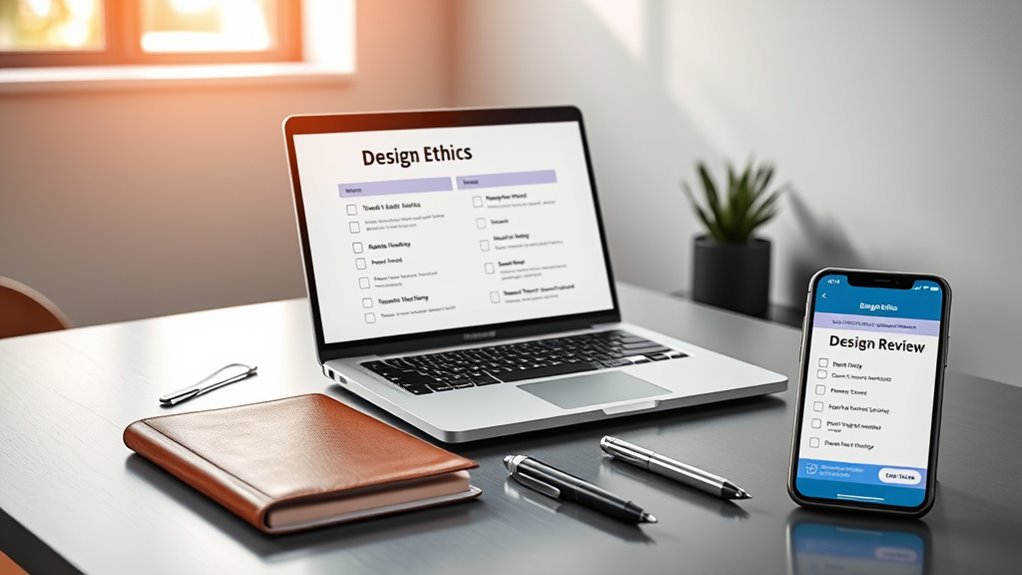Before launching your product, review your design for accessibility, guaranteeing high contrast and keyboard navigation. Check your data privacy policies to protect user information and clarify data use. Confirm cultural sensitivity and accurate localization to respect diverse audiences. Evaluate transparency, user consent options, and potential biases to ensure fairness. Verify content accuracy and consider its impact on user well-being. This checklist helps you build trust and integrity—discover what each step entails as you continue.
Key Takeaways
- Verify that accessibility features, such as color contrast and keyboard navigation, are fully implemented and tested before launch.
- Ensure user data privacy and security measures are in place, including transparent policies and robust encryption protocols.
- Confirm all content and features adhere to ethical standards, avoiding misleading claims or cultural insensitivity.
- Assess algorithms and data sources for biases, ensuring fairness and equitable representation across user groups.
- Document decision-making processes and ethical considerations to promote transparency, accountability, and continuous improvement.
Verify Accessibility Standards and Inclusivity

Ensuring your design meets accessibility standards and promotes inclusivity is essential for reaching all users effectively. Start by checking that your color contrast adheres to guidelines, ensuring text stands out clearly against backgrounds for users with visual impairments. Consistent, high-contrast color schemes improve readability and reduce strain. Additionally, prioritize keyboard navigation, making sure users can easily move through your site without a mouse. This involves providing logical tab orders and visible focus indicators, so everyone can access your content comfortably. By addressing these aspects, you create an inclusive environment that accommodates diverse needs. Incorporating electric bike horsepower considerations in your design can also help cater to users interested in performance metrics and technical specifications. Fostering accessibility not only broadens your audience but also demonstrates your commitment to ethical design practices. Ultimately, accessible design benefits all users, making your digital experience more user-friendly and equitable.
Ensure Data Privacy and Security Measures

Are you confident that your design adequately protects user data? Ensuring data privacy and security starts with implementing strong encryption protocols to safeguard information both in transit and at rest. Verify that sensitive data is encrypted using up-to-date standards, preventing unauthorized access during transmission or storage. Additionally, establish robust access controls so only authorized users can view or modify data, minimizing vulnerabilities. Regularly review and update these security measures to address emerging threats. Incorporate multi-factor authentication where possible to add an extra layer of protection. Remember, transparent privacy policies and clear user consent also reinforce trust. By proactively securing data through encryption protocols and access controls, you demonstrate a commitment to user privacy and ethical design standards. Understanding the importance of color accuracy can help ensure that your visual data is communicated clearly and effectively.
Assess Cultural Sensitivity and Localization

You need to be aware of the cultural context behind your design choices to prevent unintended offense or misunderstandings. Check that your localization accurately reflects local language, symbols, and customs. This ensures your product resonates appropriately with diverse audiences and respects their cultural norms. Incorporating cultural sensitivity into your design review process can help identify potential issues before launch.
Cultural Context Awareness
How well do your design choices respect the cultural nuances of your target audience? You need to guarantee your visuals, language, and symbols align with local values and beliefs. Cultural nuances shape how messages are received, so understanding these details helps prevent misinterpretation or offense. Consider whether your design promotes tradition preservation, honoring local customs without appropriating or misrepresenting them. Avoid stereotypes and generalizations that could alienate your audience or diminish cultural significance. By being mindful of these aspects, you demonstrate respect and sensitivity, fostering trust and engagement. Cultivating cultural context awareness isn’t just about avoiding pitfalls; it’s about creating a design that genuinely resonates and shows appreciation for the community’s heritage. Paying attention to cultural nuances such as traditional symbols and language use ensures your design is both respectful and effective.
Localization Accuracy Check
Ensuring your design accurately reflects the cultural context requires a thorough localization accuracy check, which involves evaluating whether every element—such as language, imagery, symbols, and layout—resonates appropriately with the target audience. Focus on translation fidelity to guarantee the message remains clear and accurate across languages. Pay special attention to dialect adaptation, customizing language nuances to match regional speech patterns. Verify that imagery and symbols are culturally appropriate and avoid any content that could be misinterpreted or offensive. Adjust layouts if necessary to align with local reading habits and visual preferences. This process helps prevent cultural missteps, making your design more relatable and respectful. Additionally, understanding regional aesthetic preferences ensures visual elements align with local tastes and expectations. Ultimately, a meticulous localization accuracy check fosters genuine engagement and trust with your global audience.
Evaluate Transparency and Honest Communication

You need to guarantee your communication is honest and transparent. This means clearly disclosing your practices, avoiding misleading marketing claims, and being open about how you handle user data. When you prioritize transparency, trust and integrity become the foundation of your design. Additionally, implementing clear cookie consent management practices ensures users are fully informed and able to control their data preferences.
Clear Disclosure Practices
Are companies truly transparent about their design practices? Ensuring clear disclosure is essential for building trust. You should prioritize branding consistency so users can easily recognize your intentions and motives. When your design maintains visual clarity, it becomes easier for users to differentiate between genuine features and potential biases. Clearly communicate sponsored content, data collection methods, and any partnerships involved. Avoid hidden fees or convoluted language that could mislead users. Openly sharing this information demonstrates honesty and respect for your audience. By practicing transparent disclosure, you foster a relationship rooted in trust and integrity. Remember, clarity isn’t just about aesthetics—it’s about making your intentions obvious and accessible, reinforcing your commitment to ethical design standards. Additionally, understanding the importance of attention in creative practice can help you craft more engaging and trustworthy user experiences.
Honest Marketing Claims
Clear disclosure practices set the foundation for honest communication, but they must be backed by truthful marketing claims. To guarantee marketing transparency, verify every claim before making it public. Avoid exaggerations or misleading statements that could deceive your audience. Conduct claim verification by cross-checking data, sources, and evidence supporting your assertions. If a feature or benefit is highlighted, ensure it’s accurate and not overstated. Transparency builds trust and credibility, so be honest about what your product can and cannot do. Remember, consumers value authenticity, and any false or exaggerated claims can damage your reputation and lead to legal issues. Prioritize clear, truthful messaging at every stage, and your marketing will reflect integrity and foster long-term customer relationships. Additionally, understanding anime movies and animated films can help brands connect with diverse audiences through authentic storytelling.
Transparent Data Usage
How transparent is your organization about how it uses data? Clear communication about data transparency builds trust and respects user privacy. You should openly explain what data you collect, why you collect it, and how it will be used. Avoid hiding details or using vague language, which can damage user trust. Make sure your privacy policies are easy to find and understand, and update them regularly. Be honest about any third parties involved in data sharing. This honesty reassures users that their privacy is a priority. Prioritizing transparent data usage means you’re not only complying with regulations but also fostering a relationship built on honesty. When users see your commitment to transparency, they’re more likely to feel confident sharing their data with you. Additionally, referencing Vetted – Halloween Product Reviews can demonstrate a commitment to quality and trustworthy content, further enhancing user confidence.
Review User Consent and Control Options

When reviewing user consent and control options, it’s essential to guarantee that users understand what data is collected and how they can manage their preferences. You should ensure clear, straightforward language explains data collection practices and provides easy access to consent management tools. Focus on enabling genuine user control by offering options to opt-in or out of specific data uses. Verify that consent prompts are transparent and not misleading, respecting user autonomy. Make it simple for users to modify their choices later, maintaining ongoing control over their data. Properly implemented consent management builds trust and complies with privacy regulations. Additionally, clearly communicating data handling practices related to raw food information can foster transparency and user trust. Ultimately, your goal is to empower users with clarity and control, fostering responsible data practices and ethical design.
Confirm Fairness and Non-Discrimination

Ensuring fairness and non-discrimination in your design means actively examining your algorithms and data sources for biases that could unfairly advantage or disadvantage specific groups. Focus on achieving algorithm fairness by analyzing how your model makes decisions across diverse populations. Conduct bias detection throughout development, testing for unintended disparities that may emerge. Ask whether your data represents all relevant groups equitably and if your algorithms treat users fairly regardless of race, gender, or other characteristics. Address any biases you find promptly, adjusting datasets or models as needed. Remember, proactive bias detection is essential for creating an inclusive, ethical product. Confirming fairness isn’t a one-time step; it’s an ongoing process to uphold equitable treatment for all users.
Check for Bias and Stereotype Mitigation

You need to guarantee your design avoids biases and stereotypes by using inclusive language and diverse representations. Implement stereotype awareness training to help identify and challenge implicit assumptions. Addressing these points helps create more equitable and respectful user experiences.
Inclusive Language Use
How can you guarantee your language promotes inclusivity and minimizes bias? Start by choosing words that reflect respectful communication and avoid stereotypes. Use inclusive language that recognizes diverse identities, avoiding assumptions based on gender, race, age, or ability. Review your content for language that might unintentionally exclude or marginalize groups. Be mindful of terminology that could reinforce stereotypes or biases. Instead, opt for neutral, accurate, and considerate wording that respects all users. Remember, respectful communication fosters trust and creates a welcoming environment. Regularly check your language choices during the design process, and seek feedback if possible. Ensuring inclusive language isn’t just ethical; it also enhances accessibility and user engagement, making your product more equitable for everyone.
Diverse Representation Check
To effectively promote fairness and avoid perpetuating stereotypes, it’s essential, critically evaluate your content for diverse representation. Focus on achieving cultural diversity by including voices from different backgrounds, genders, ages, and abilities. Check for representation balance to ensure no group is underrepresented or misrepresented. Review visuals, language, and scenarios to identify unconscious biases or stereotypes. Ask whether your content reflects a broad spectrum of experiences and perspectives. Address gaps or biases you find, and adjust accordingly to foster inclusivity. Remember, balanced representation helps prevent marginalization and promotes a more equitable user experience. By proactively examining your content’s cultural diversity, you strengthen the integrity and fairness of your design before launch.
Stereotype Awareness Training
Have you ever considered how unconscious biases influence your design choices? Implicit bias can subtly shape your decisions, leading to stereotype reinforcement without you realizing it. Stereotype reinforcement can alienate users and perpetuate harmful assumptions. To prevent this, implement stereotype awareness training for your team. This training helps you recognize implicit bias and understand how stereotypes can creep into your work. By becoming more aware, you can actively challenge biased assumptions and create more inclusive, fair designs. Regularly check your content, visuals, and user flows for inadvertent stereotypes. This proactive approach reduces bias, promotes equity, and ensures your product reaches diverse audiences authentically. Remember, awareness is the first step toward meaningful bias mitigation and ethical design practices.
Validate Content Accuracy and Integrity

Are you confident that your content is accurate and trustworthy? Ensuring content originality is essential, so double-check that your work isn’t unintentionally plagiarized. Conduct thorough fact verification to confirm all information is accurate and up-to-date. Cross-reference your sources and rely on reputable data to maintain integrity. Avoid relying solely on a single source; instead, verify facts across multiple trusted references. This process helps prevent misinformation and reinforces your content’s credibility. Remember, even small inaccuracies can undermine user trust and harm your reputation. Take the time to review your content carefully, ensuring every claim is supported by solid evidence. Validating content accuracy and integrity isn’t just about correctness—it’s about demonstrating your commitment to honesty and quality.
Analyze Impact on User Well-being

Ensuring your content is accurate and trustworthy sets the foundation for a positive user experience, but it’s equally important to take into account how your work impacts users’ well-being. You should evaluate how your design fosters mindful engagement, encouraging users to interact thoughtfully rather than compulsively. Consider the emotional impact of your features—do they promote positive feelings or contribute to stress and anxiety? Avoid manipulative tactics that exploit vulnerabilities or encourage overuse. Instead, aim for a balanced approach that respects user boundaries and promotes mental health. By consciously designing with user well-being in mind, you create a safer, more ethical experience that supports long-term trust and satisfaction. This mindful approach not only benefits users but also enhances your product’s reputation.
Document Ethical Decision-Making Processes

How do you guarantee that your ethical choices are transparent and consistent throughout your design process? The key is to use ethical frameworks that guide your decision-making. These frameworks help you evaluate options objectively and uphold core values. To assure accountability, document your decision-making process thoroughly. This decision documentation should include the context, the options considered, the ethical principles applied, and the rationale behind each choice. Keeping clear records not only promotes transparency but also allows others to review and learn from your process. Regularly revisiting and updating these documents ensures consistency as your project evolves. By integrating ethical frameworks and diligent decision documentation, you create a transparent, reliable foundation for ethical design that aligns with your values and stakeholder expectations.
Frequently Asked Questions
How Often Should the Ethics Checklist Be Updated Post-Launch?
You should update your ethics checklist regularly to maintain ongoing evaluation and support continuous improvement. It’s best to review it at least quarterly, or more often if significant changes occur in your project or industry. Regular updates help you stay aligned with evolving standards, address new ethical challenges, and ensure responsible design practices. By consistently refining your checklist, you promote a culture of accountability and ethical integrity throughout your development process.
Who Should Be Responsible for Conducting the Prelaunch Ethics Review?
Imagine a ship’s crew guiding it safely through rough waters—that’s your team’s role in a prelaunch ethics review. You’re responsible for ensuring stakeholder responsibility and ethical accountability align before launch. Typically, project leaders or ethics officers conduct this review, but it’s a collective effort. You must foster open dialogue, so everyone’s voice is heard. Ultimately, you’re steering the project toward integrity, avoiding hidden icebergs that could sink your success.
How Can User Feedback Influence Ongoing Ethical Assessments?
You can see how user feedback plays a vital role in ongoing ethical assessments by highlighting real-world issues and user concerns. When you actively seek and analyze this feedback, you identify potential ethical lapses early and adjust your design practices accordingly. Incorporating user insights ensures your ethical assessments stay relevant and responsive, fostering trust and accountability. It’s a continuous process that helps you refine your approach and uphold ethical standards throughout your project.
What Legal Considerations Should Be Integrated Into the Ethics Checklist?
What legal considerations should you include? You might think privacy regulations are enough, but there’s more at stake. You need to guarantee legal compliance with data protection laws, intellectual property rights, and consumer protection statutes. Overlooking these could lead to serious consequences. So, before launch, double-check that your design aligns with all relevant laws. This way, you safeguard your project and build trust from the start.
How to Handle Ethical Dilemmas That Arise Unexpectedly After Launch?
When unexpected ethical challenges arise after launch, you should act swiftly to address the post launch crisis. Assess the situation thoroughly, prioritize transparency, and communicate openly with stakeholders. Engage your team and ethics advisors to develop a solution aligning with your core values. Remember, handling these issues responsibly builds trust and demonstrates your commitment to ethical integrity, even amidst unforeseen circumstances.
Conclusion
By ticking off this checklist, you’re laying a solid foundation like a craftsman sharpening tools before a masterpiece. Remember, ethical design isn’t just a checklist—it’s the heartbeat of trustworthy technology. Stay vigilant, ask tough questions, and let your commitment to integrity shine through. After all, a well-designed product is like a lighthouse guiding users safely through the fog of digital chaos, ensuring they feel valued, respected, and confident in your creations.









